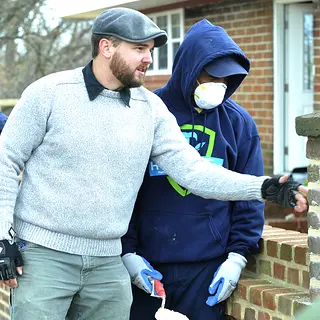
The Outdoor Classroom
The Historic Preservation Training Center’s Approach to Preservation Education
It’s been a busy first nine months for the Hands-On Preservation Experience. From historic stable rehabilitation in Virginia, to headstone cleaning and repair in Montana, and shotgun house repairs in Georgia, the program’s burgeoning portfolio of diverse projects has seen over 100 young people and veterans from all across the country introduced to the world of preservation.
The National Trust has not been able to do this alone, as the success of this program lies in the partnerships that have formed since its beginning. From the Corps Network’s direct connection to 100+ corps in all 50 states, to the National Park Service’s array of fully funded projects, these projects would not have been possible without our partners’ shared vision of providing training and education opportunities for corpsmembers.
Of the many and varied partners involved in HOPE Crew, few are as well-positioned to help ensure work meets the Secretary of Interior’s Standards -- and open the door to for future careers in preservation -- quite like the Historic Preservation Training Center.
“We consider ourselves very fortunate to be partnered with HPTC,” says Monica Rhodes, who oversees the HOPE Crew program for the National Trust. “The current NPS staff members who have gone through similar training have shown a real commitment to the philosophy behind HOPE Crew. HPTC works to instill a preservation ethic within everyone they touch, and HOPE Crew participants are no exception.”

photo by: Nancy Pierce
Corpsmembers were able to get up close and personal with the historic brickwork at Raleigh National Cemetery.
Headquartered in Frederick, Maryland, HPTC is one of three training centers within the National Park Service’s Training and Development Division. With a primary mission of developing preservation trade skills for NPS, it also operates as a preservation construction service, taking on roughly $12-13 million in projects each year.
“We have a full workload, and thus a classroom and opportunities for experiential learning,” says HPTC Superintendent Chris Robinson. “When we take on a project to, say, replace a slate roof in Hyde Park (New York), that then becomes our classroom, whether it’s for a corpsmember or one of our exhibit specialist trainees.”
This month, the classroom is the Raleigh National Cemetery in North Carolina, where members of the Northwest Piedmont Service Corps from nearby Winston-Salem are completing their two-month immersion in preservation masonry. Under the instruction and supervision of HPTC craft expert Phillip Bailey, a group which includes both youth and military veterans are repointing the brick retaining wall enclosing the Civil War-era cemetery located in the heart of the state capitol.
“It’s a great experience, and they’re really taking to the work,” says Bailey. “A lot of them have no masonry experience whatsoever, but having a clean slate like that means they’re really taking to the different preservation techniques, which is a little bit different then your typical main-line construction company would go about it.”

photo by: Nancy Pierce
An HPTC staff member mixes replacement mortar for the wall.
The teaching element has not slowed down of the work itself, though; Bailey estimates the crew so far has repointed 114 panel sections of the wall -- the equivalent of 8.5 miles of brick (39,966 bricks in all). The process is paying dividends for everyone involved, from the corpsmembers themselves, all the way up to the site owners -- in this case, the Department of Veterans Affairs' (VA) National Cemetery Administration.
“I believe that everybody’s benefiting from the HOPE Crew program assisting the Park Service in getting the renovation done in a timely fashion,” says Dean Randgaard, a Program Support Assistant for the VA. “The HOPE Crew folks are learning a bit about how the masonry field might be a good fit for them.”
In addition to teaching valuable preservation skills, the experiential learning model also lends toward crew members gaining a deeper understanding and appreciation for their work site, such as this nearly 150-year-old cemetery which serves as the final resting place for veterans dating back to 1865.
“I didn’t know anything about masonry at first, and now I’m learning about the essentials,” says corpsmember Mario Vaughn, also a veteran of the Marine Corps. “Both in terms of what goes into the actual work, and also in how I’m helping to preserve something that’s worth preserving as far as the sacrifice that was made [by these veterans].”
On-the-job training with HPTC staff is introducing corpsmembers to an industry with a clear and recognized need for a new generation to enter its workforce.
“With the types of skills I’ve picked up here, I’m learning what it takes to be a brick mason. Working with HOPE Crew has helped me get an outlook not only on giving back, but also looking at training programs and different trades I can take up.””
James McClellan of the Northwest Piedmont Service Corps

photo by: Nancy Pierce
Introducing HOPE Crew participants to a career path in preservation construction has been a goal since the program’s inception, but it’s through a partnership with HPTC that comes with the unique opportunity to directly connect crew members to potential opportunities with the National Park Service.
“That’s the goal,” said Robinson. “Our more long-term vision is really to use our ability to reach corpsmembers as a means of introducing youth into our workforce with the hope that we will identify individuals that we think deserve, and are exhibiting, the talent that we want to fill a permanent position, and actually go into a more formal development program.”
So far, the National Trust has worked with the HPTC on six of the program’s first 15 projects, and with many more on the horizon in 2015, the future of this strong partnership appears just as bright as those of HOPE Crew alumni.
Check out this video about the Raleigh National Cemetery project:



